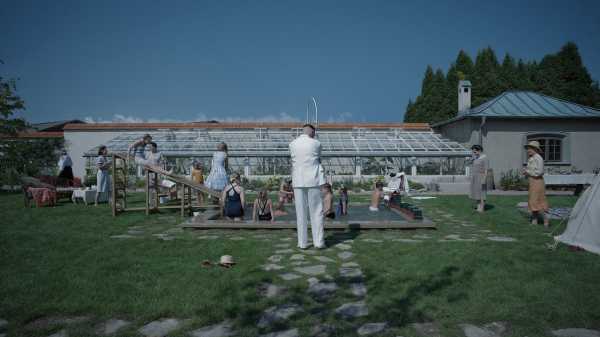
Save this storySave this storySave this storySave this story
With movies that are based on books, there’s no inherent merit in either fidelity or infidelity. What matters is the sense of freedom, of using a book to one’s own purposes. That’s the best thing about “The Zone of Interest,” the writer and director Jonathan Glazer’s adaptation of Martin Amis’s 2014 novel of the same title. Glazer transforms it drastically and makes it feel almost entirely like his own creation. The novel is narrated by way of the characters’ monologues, and they’re mostly schtick-laden, performative voices—Amis’s novel plays largely like a variation on “Portnoy’s Complaint” with its prime complainants being fictionalized Nazis who run Auschwitz. I’m not a fan of the book, which strikes me as a near-parody of the Holocaust, with torrentially erotic eruptions of lust, jealousy, and absurdity applied to the sordid private lives of fictitious Nazi officials and mass murderers. (It also prominently features one Jewish character, Szmul, the leader of the Sonderkommando—Jewish inmates under orders to do much of the physical labor involved in mass murder, such as shaving hair, guiding captives to gas chambers, and shovelling out the ashes. Szmul’s voice, though written briefly and thinly, is lent a moving earnestness, but his destiny is the stuff of pulp fiction.)
Glazer’s film distills and transforms the novel’s premise into an altogether different story and tone. It’s a sort of narrowly bordered bio-pic, centered on the real-life Höss family: Rudolf Höss (Christian Friedel), a longtime Nazi and S.S. member who was one of the commandants of Auschwitz; his wife, Hedwig (Sandra Hüller), nicknamed Hedy; and their three daughters and two sons, ranging from an adolescent to an infant. They live in a gracefully appointed house just outside the walls of the death camp; the property abuts the walls, which, with their curved barbed-wire stanchions, are instantly recognizable. They live a largely ordinary family life: they picnic by the river, Hedy tends her garden, the children go to school; there are birthday celebrations and social gatherings. But some details stand out. Hedy does her “shopping” for clothing, cosmetics, and jewelry from among items confiscated from deportees. (One friend found a diamond in a confiscated tube of toothpaste, declaring, “They are very clever.”) On a river swim, Rudolf finds something in the water that makes him rush his children home and scrub them and himself thoroughly. The ambient soundtrack of daily life is the barking of dogs, the shouts of officers, the screams of captive victims, gunshots, and the roar and smoke of crematoria. (As Rudolf and one of his sons ride on horseback through nearby fields, amid yelling as prisoners are driven through the area, the son calls attention to the sound: “Do you hear that? . . . A bittern. A heron. A Eurasian gray heron.”)
The movie’s prime drama is the conflict between professional life and family happiness. Höss, considered a good manager, is promoted to a higher position and sent to the German town of Oranienburg (the site of the Sachsenhausen concentration camp). But Hedwig, who is happy in the Auschwitz house and in its surrounding rural landscape, pressures Rudolf to beg his superiors to let her and the children continue to live there in his absence. The unhappy Höss bids farewell to his horse (yes, to his horse: “I love you; I love you, my beauty”) and to Hedwig. He heads to Germany, alone, where he’s part of the beau monde but takes no pleasure in it, reporting to Hedy by phone that he hardly noticed all the aristocrats and notables at a fancy-dress ball because he was too busy imagining the trouble he’d have gassing everyone in the high-ceilinged room.
If this sounds borderline hilarious, it should, because the movie is an extreme form of Holokitsch; it’s this year’s “Jojo Rabbit.” Glazer’s movie is a presentation of nearly unfathomable horrors by way of bathos, alluding to enormities in the form of minor daily inconveniences. There’s conceptual audacity in the effort, yet Glazer doesn’t display the courage or the intellectual rigor to pull it off successfully; if he did, he’d have centered the movie strictly on Hedy’s and the children’s experiences and points of view, noting the hints and traces of the death camp in and near the house and amid the landscape. The movie would have shown Rudolf and his activities solely through their eyes, thus making their surmises and their doubts, or their willful indifferences, all the more conspicuous—the movie wouldn’t have noted any more details of the horrors than they did.
Instead, much of the movie follows Rudolf, not just in his family life but also in his daily business—but only so far. Rudolf sees and knows everything that goes on in Auschwitz and in the death camps over all, but Glazer shows him only involved in bureaucratic activities. He reviews plans for a circular crematorium that can operate continuously. He attends a meeting of concentration-camp directors who are exhorted to furnish workers for German factories, while also being prepared to receive—and, for the most part, exterminate—the many Hungarian Jews who are about to be deported from their homeland (as actually happened, in 1944). Rudolf is an eyewitness to the atrocities relentlessly perpetrated under his command within the walls of Auschwitz, but Glazer dispenses with the problem of dramatizing or representing—or even describing—them. In the process, he shrinks from portraying the horrors of the real-life Höss’s character, too, and, as a result, he trivializes them.
Glazer’s diminution of the perpetrators themselves is a cinematic reinforcement of Hannah Arendt’s notion of the banality of evil: of deportation and extermination as the product of the numbingly mindless routine of the bureaucratic mind. But just as Adolf Eichmann is now understood to have been no mere paper-pusher but a rabid antisemite who took to his death-dealing duties with enthusiasm, Höss wasn’t just a skillful technocrat—he was a longtime Nazi true believer, going back to the nineteen-thirties with decades of blood on his hands. (Amis at least gets that straight, albeit cloaking it in antic language.) There’s no room for rabidness in the movie, however, no ideological talk or overt hatred. There’s also no room for the victims: prisoners, serving as forced laborers, appear around the house throughout the film, but silently. They’re given neither any voice nor any point of view.
Still, Glazer wants to stress that the banalities in question are no mere banalities; they’re grim and grave. Unlike pretty much any other movie that opens with a family picnic in a charming riverside landscape, the movie begins with more than two minutes of a black screen, accompanied by music (by Mica Levi) so bleak that it makes Mahler’s Ninth sound like Carl Stalling. In other words, before the first dramatic image, Glazer has essentially proclaimed the movie’s deep seriousness, and his own. Lest any viewer get too lost in the bright-green weeds of the Höss family’s daily routines, Glazer punctuates the movie with hallucinatory sequences, with eerily expressionistic black-and-white, night-vision thermal images, featuring music like sepulchral belches from the Earth’s depths. In these scenes, one of the Höss daughters goes on solitary and secretive routines of gathering (seemingly where bodies are buried) and of depositing (of apples beside shovels where inmates likely do forced labor). At one point, an image of smoke whites out the screen; at another, closeups of flowers, accompanied on the soundtrack by horrible yelling and screaming, fade to an all-blood-red screen.
By gussying up such sequences as cinematic emergencies rather than as regular rounds like those of the rest of the film, Glazer again and again emphasizes that the film’s apparent ordinariness is faux—that these daily lives are indeed extraordinary and horrific, elements of a historic tragedy. Yet his blatant exertion to get that point across suggests a lack of confidence that viewers will get the point from the drama alone—and a fear that his dramatic choices indeed risk diminishing those horrors. The filmmaker appears to want it both ways—to make subtle allusions that are given meaning by vehement jolts, to avoid specifics while pounding out generalized emotions.
There are moments that suggest an earnest and substantial inspiration that, however, remains largely undeveloped. One of the Höss daughters appears to have found a folded-up sheet of lyrics, titled “Sunbeams,” by the real-life Auschwitz inmate and survivor Joseph Wulf; she plays the piano, as if inwardly setting it to her music, as its words appear onscreen in subtitles. (Did she scavenge the poem in her black-and-white, night-vision wanderings? The physical practicality behind such a moment is exactly the sort of exalted ordinariness that virtually cries out for a straightforward, dramatically direct and detailed approach.) There’s a character who casually opens an abyss of a backstory: Hedwig’s mother, Linna Hensel (Imogen Kogge), while walking with Hedwig in the family garden beside the death camp’s wall, wonders out loud, “Maybe Esther Silberman is over there . . . the one I used to clean for.” (But then Glazer lays it on thick, with Linna’s complaint that she was “outbid” for Esther’s curtains.)
Glazer’s purely external depiction of Auschwitz—its outer walls only—is of a piece with his reconstruction of life in its vicinity: he keeps his hands clean. He models his vision of the Höss family circle, and of the Holocaust, on his own formidable artistic dignity. The movie ends, pardon my spoiler, at the current-day museum that is Auschwitz. Glazer films employees cleaning inside a former gas chamber and in the halls and corridors where piles of shoes, crutches and other medical devices, and uniforms of inmates are on display. He seems to suggest that there’s such a thing as the banality of good, too, yet it remains similarly muted and abstract. He doesn’t deign to hear what the workers have to say. ♦
Sourse: newyorker.com







